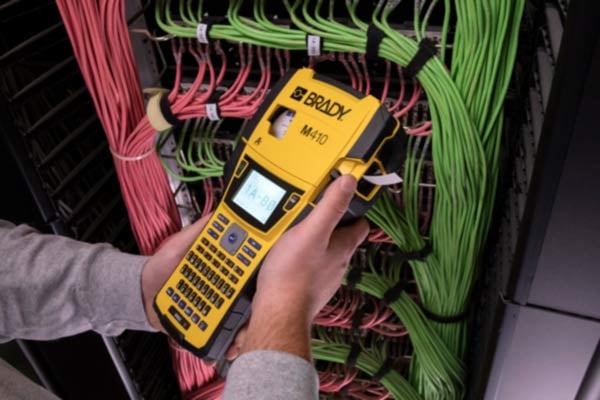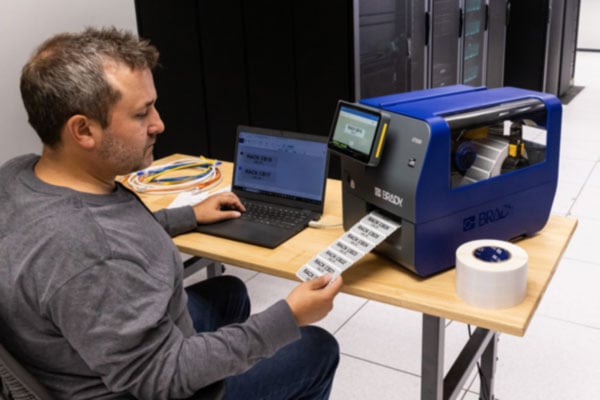Best Practices for Data Center Cable Management: Strategies for Organization and Efficiency
Cable management involves organizing and securing network cables in a data center to ensure efficient operation and maintenance. Proper cable management improves network performance by reducing signal interference and improving airflow, which aids in efficient cooling. It also facilitates easy access for troubleshooting and managing equipment.
Conversely, poor cable management can obstruct airflow, leading to overheating; and create a tangled web that complicates troubleshooting, increasing the risk of costly downtime and escalating maintenance efforts. Well-organized cabling systems extend equipment life and also optimize a data center's overall functionality and reliability.
Brady has the products and expertise you need to keep your data center running smoothly. Download our brochure to get the full solution. Get the BrochureCommon challenges of poor cable management
Tangled and unorganized cables can create a host of problems in data centers, including signal interference and damage to the cables. This disarray complicates troubleshooting, especially when cables are improperly labeled or routed which dramatically increases the time required to resolve network issues.
Working with fragile fiber optic cables presents additional hurdles with their greater need for precision and sensitivity to dust or contamination. Effective data center fiber optic cable management is crucial for optimizing network performance, ensuring easy maintenance and preventing disruptions.
Unmanaged cables crowd racks and pathways, resulting in inefficient use of space and making it difficult to access equipment. Moreover, poor cable management obstructs airflow, causing equipment to overheat and degrading overall performance. Such inefficiencies not only threaten the longevity of hardware, but also result in costly downtime and increased maintenance demands.

Best practices for cable organization and labeling
Implementing industry standards such as TIA-942, TIA-606-C, and TIA-568 is essential for efficient data center cable management. These standards provide guidelines for organizing cables, ensuring that they are properly labeled and routed to minimize clutter and optimize performance. By adhering to such standards, data centers can enhance their operational efficiency and reliability.

Implementing color-coded cable labels
Color-coded cable labels offer a quick and efficient method for cable identification, significantly reducing the time spent during maintenance and troubleshooting. Common schemes include using blue for network cables and yellow for fiber optic cables, making it easy to differentiate between types at a glance.
Fiber optic cables often follow a standardized color code, such as orange for multimode and yellow for single-mode. Adopting a consistent and standardized color-coding system ensures uniformity across the facility, helping technicians easily identify cable functions and connections. Regular audits and updates to the color-coding scheme keep the system reliable, accommodating changes in network architecture over time.
Using heat-shrink tubing for durable labeling
Heat-shrink tubing offers superior cable identification and longevity by securely fitting around cables when heated, providing robust protection against wear and tear. Unlike standard adhesive labels that can peel or fade over time, heat-shrink tubing remains intact and legible. For optimal results, apply the tubing evenly around clean cables and take care to ensure their proper alignment before shrinking. This supports maximum grip and clarity.
Optimizing cable routing and bundling
Organized cable routing enhances airflow and equipment accessibility while reducing maintenance time. Use cable trays, ladder racks and VELCRO® wraps over zip ties to prevent cable damage and facilitate adjustments. Proper bundling minimizes signal interference and wear by evenly distributing cable weight and tension, which prolongs cable lifespan and ensures reliable network performance.
Tools and solutions for effective cable management
Cable management challenges, such as clutter and inefficiency, can be effectively addressed with the right tools. These solutions streamline operations, enhance organization and protect cable infrastructure.

Label printers and cable labeling solutions
High-quality label printers simplify cable identification, enhancing both organization and efficiency in a data center. Choosing the right type of printer is crucial; portable printers are ideal for on-site flexibility, while industrial printers offer robust solutions for large-scale operations. Both options ensure that labels are durable and legible. Pre-printed labels further streamline this process by reducing manual input and minimizing error risks — ultimately fostering a more organized and error-free environment.
QR codes and barcoded labels for tracking
QR codes and barcodes streamline asset tracking by providing easy access to detailed information. In data centers, scannable labels on cables and equipment allow for swift referencing during maintenance and troubleshooting. This technology enables technicians to quickly verify connections without extensive manual checks. For instance, barcode tracking can significantly enhance inventory management by updating system records in real time, reducing errors and optimizing stock levels. Such advancements boost overall operational efficiency while maintaining precision.
Portable labeling solutions for on-the-go management
Handheld label printers are invaluable tools for technicians needing to create labels on-site, especially in expansive data centers. These mobile devices provide the flexibility to quickly update or replace labels as needed without returning to a workstation. This simple convenience significantly reduces downtime and improves operational flow.
For large-scale data centers, mobile labeling ensures that identification protocols are consistently upheld, even in remote or hard-to-reach locations. When selecting a portable labeling solution, consider factors such as battery life, ease of use, print durability and connectivity options. Features like Bluetooth or Wi-Fi connectivity can enhance functionality — allowing for seamless integration with inventory systems — while durable construction features ensure the printer can withstand the rigors of daily use.
How Brady can help
We confidently back our solutions with the know-how and skills needed to maintain efficient infrastructures. Our data center cable management solutions are rooted in material science and driven by unmatched expertise. Easily create custom labels for endless color coding options. Save time with automated labeling with printers that can print and wrap cables in just seconds. From cables and server racks to equipment and assets, Brady has a full range of identification solutions that can be tailored to any data center.
